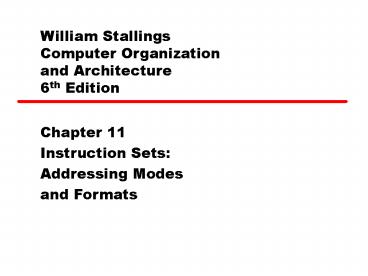William Stallings Computer Organization and Architecture 6th Edition - PowerPoint PPT Presentation
Title:
William Stallings Computer Organization and Architecture 6th Edition
Description:
William Stallings Computer Organization and Architecture 6th Edition Chapter 11 Instruction Sets: Addressing Modes and Formats Addressing Modes Immediate Direct ... – PowerPoint PPT presentation
Number of Views:164
Avg rating:3.0/5.0
Title: William Stallings Computer Organization and Architecture 6th Edition
1
William Stallings Computer Organization and
Architecture6th Edition
- Chapter 11
- Instruction Sets
- Addressing Modes
- and Formats
2
Addressing Modes
- Immediate
- Direct
- Indirect
- Register
- Register Indirect
- Displacement (Indexed)
- Stack
3
Immediate Addressing
- Operand is part of instruction
- Operand address field
- e.g. ADD 5
- Add 5 to contents of accumulator
- 5 is operand
- No memory reference to fetch data
- Fast
- Limited range
4
Immediate Addressing Diagram
Instruction
Operand
Opcode
5
Direct Addressing
- Address field contains address of operand
- Effective address (EA) address field (A)
- e.g. ADD A
- Add contents of cell A to accumulator
- Look in memory at address A for operand
- Single memory reference to access data
- No additional calculations to work out effective
address - Limited address space
6
Direct Addressing Diagram
Instruction
Address A
Opcode
Memory
Operand
7
Indirect Addressing (1)
- Memory cell pointed to by address field contains
the address of (pointer to) the operand - EA (A)
- Look in A, find address (A) and look there for
operand - e.g. ADD (A)
- Add contents of cell pointed to by contents of A
to accumulator
8
Indirect Addressing (2)
- Large address space
- 2n where n word length
- May be nested, multilevel, cascaded
- e.g. EA (((A)))
- Draw the diagram yourself
- Multiple memory accesses to find operand
- Hence slower
9
Indirect Addressing Diagram
Instruction
Address A
Opcode
Memory
Pointer to operand
Operand
10
Register Addressing (1)
- Operand is held in register named in address
filed - EA R
- Limited number of registers
- Very small address field needed
- Shorter instructions
- Faster instruction fetch
11
Register Addressing (2)
- No memory access
- Very fast execution
- Very limited address space
- Multiple registers helps performance
- Requires good assembly programming or compiler
writing - N.B. C programming
- register int a
- c.f. Direct addressing
12
Register Addressing Diagram
Instruction
Register Address R
Opcode
Registers
Operand
13
Register Indirect Addressing
- C.f. indirect addressing
- EA (R)
- Operand is in memory cell pointed to by contents
of register R - Large address space (2n)
- One fewer memory access than indirect addressing
14
Register Indirect Addressing Diagram
Instruction
Register Address R
Opcode
Memory
Registers
Operand
Pointer to Operand
15
Displacement Addressing
- EA A (R)
- Address field hold two values
- A base value
- R register that holds displacement
- or vice versa
16
Displacement Addressing Diagram
Instruction
Address A
Register R
Opcode
Memory
Registers
Pointer to Operand
Operand
17
Relative Addressing
- A version of displacement addressing
- R Program counter, PC
- EA A (PC)
- i.e. get operand from A cells from current
location pointed to by PC - c.f locality of reference cache usage
18
Base-Register Addressing
- A holds displacement
- R holds pointer to base address
- R may be explicit or implicit
- e.g. segment registers in 80x86
19
Indexed Addressing
- A base
- R displacement
- EA A R
- Good for accessing arrays
- EA A R
- R
20
Combinations
- Postindex
- EA (A) (R)
- Preindex
- EA (A(R))
- (Draw the diagrams)
21
Stack Addressing
- Operand is (implicitly) on top of stack
- e.g.
- ADD Pop top two items from stack and add
22
Pentium Addressing Modes
- Virtual or effective address is offset into
segment - Starting address plus offset gives linear address
- This goes through page translation if paging
enabled - 12 addressing modes available
- Immediate
- Register operand
- Displacement
- Base
- Base with displacement
- Scaled index with displacement
- Base with index and displacement
- Base scaled index with displacement
- Relative
23
Pentium Addressing Mode Calculation
24
PowerPC Addressing Modes
- Load/store architecture
- Indirect
- Instruction includes 16 bit displacement to be
added to base register (may be GP register) - Can replace base register content with new
address - Indirect indexed
- Instruction references base register and index
register (both may be GP) - EA is sum of contents
- Branch address
- Absolute
- Relative
- Indirect
- Arithmetic
- Operands in registers or part of instruction
- Floating point is register only
25
PowerPC Memory Operand Addressing Modes
26
Instruction Formats
- Layout of bits in an instruction
- Includes opcode
- Includes (implicit or explicit) operand(s)
- Usually more than one instruction format in an
instruction set
27
Instruction Length
- Affected by and affects
- Memory size
- Memory organization
- Bus structure
- CPU complexity
- CPU speed
- Trade off between powerful instruction repertoire
and saving space
28
Allocation of Bits
- Number of addressing modes
- Number of operands
- Register versus memory
- Number of register sets
- Address range
- Address granularity
29
PDP-8 Instruction Format
30
PDP-10 Instruction Format
31
PDP-11 Instruction Format
32
VAX Instruction Examples
33
Pentium Instruction Format
34
PowerPC Instruction Formats (1)
35
PowerPC Instruction Formats (2)
36
Foreground Reading
- Stallings chapter 11
- Intel and PowerPC Web sites































